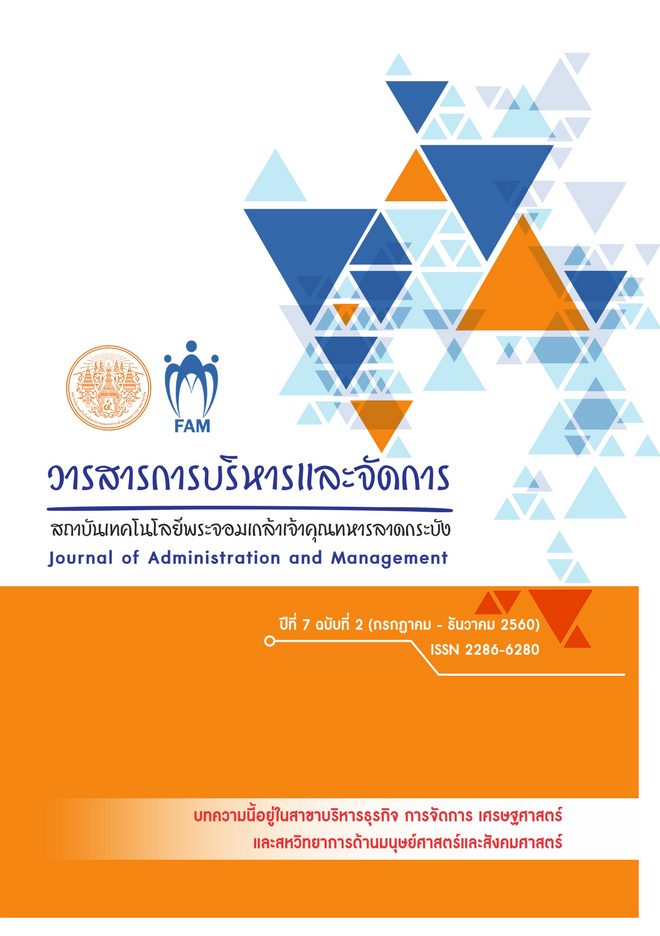The Contemporary of Human Resource Management in Thai Organization: Qualitative Study
Main Article Content
Abstract
This qualitative study was aimed for studying the HRM contemporary concepts, Roles of HR contemporary managers and Tools of contemporary HRM. All data were collected from two sources which were from 1) documents and websites 2) In-depth interview from HR academic officer, Consultants, HR Directors and HR Administrators in private and public organizations, 27 samples totally. These data were collected during October 2014 to October 2015 which were analyzed by oriented content studying. The results had been shown as follows: 1) HRM Strategy 2) HRD Strategy 3) Human Capital Management 4) Competency of HRM 5) Talent Management 6) HR Information System 7) HRM Diversity in workplace 8) Multi-national Labor Management 9) HRM in Multi-national Organization 10) Innovation in HRM 11) Philosophy of Sufficiency Economy in HRM 12) Human Resource Management with Analysis 13) HR Risk Management 14) HR in Buddhist Management 15) HRM by nature and other concepts. And the roles of contemporary HR Managers are as follows : 1) Partnership Strategy 2) Administrative Expert 3) Employee Contributors 4) Leader Changing 5) HR Performing Strategy 6) Consultant 7) Evaluator 8) Creating Value 9) Supporter 10) Researcher, and etc. About Tools of HRM contemporary are as follows : 1) HR Indicators 2) HR Balanced Scorecard 3) Interviewing Application Form 4) Recruitment of Phycology Test 5) Training Evaluation Form 6) Performance Appraisal Form 7) Individual Potential Form 8) Competency Test 9) Extended DISC and etc.
Article Details
Journal of KMITL Business School is available both online and in printed version.
**All articles or opinions presented in this issue of the Journal of KMITL Business School reflect the thoughts of their respective authors. This journal serves as an independent platform for a variety of viewpoints. Authors bear full responsibility for the content of their articles.**
**All articles published in this journal are copyrighted by KMITL Business School, King Mongkut's Institute of Technology Ladkrabang. The editorial team permits copying or using articles, but a reference to the journal is required.**
References
จิระประภา อัครบวร. (2550). ตัวชี้วัดในงานทรัพยากรมนุษย์. กรุงเทพฯ : คณะพัฒนาทรัพยากรมนุษย์ สถาบันบัณฑิตพัฒนบริหารศาสตร์ (นิด้า)
จีระ หงส์ลดารมภ์. (2555). 8K’s+5K’s ทุนมนุษย์ของคนไทยรองรับประชาคมอาเซียน. กรุงเทพฯ : โรงพิมพ์จุฬาบุ๊ค.
ชูชัย สมิทธิไกร . (2550). การสรรหา การคัดเลือก และการประเมินผลการปฏิบัติงานของบุคลากร. พิมพ์ครั้งที่ 2. กรุงเทพฯ : วี. พริ้นท์ (1991).
ประดิษฐ ภัทรประสิทธิ์. (2558). การจัดการทรัพยากรมนุษย์ตามธรรมชาติ. เอกสารประกอบการบรรยายการจัดการทรัพยากรมนุษย์ในองค์การ.
พิชิต เทพวรรณ์. (2554). การจัดการทรัพยากรมนุษย์เชิงกลยุทธ์ : แนวคิดและกลยุทธ์เพื่อความได้เปรียบในการแข่งขัน. กรุงเทพฯ : ซีเอ็ดยูเคชั่น.
ภิราช รัตนันต์. (2559). รายงานการวิจัย เรื่อง การบริหารทรัพยากรมนุษย์เชิงกลยุทธ์ขององค์การธุรกิจในเขตภาคเหนือตอนล่าง 2. นครสวรรค์. คณะวิทยาการจัดการ มหาวิทยาลัยราชภัินครสวรรค์.
.................... (2558). รายงานการวิจัย เรื่อง การจัดการทรัพยากรมนุษย์ร่วมสมัยขององค์การไทย : การศึกษาเชิงคุณภาพ. นครสวรรค์ : คณะวิทยาการจัดการ มหาวิทยาลัยราชภัฏนครสวรรค์.
………………… (2558). พันธกิจและบทบาทของการบริหารทรัพยากรมนุษย์ในองค์การ. วารสารวิชาการและวิจัยสังคมศาสตร์ ปีที่ 10 (30 ก.ย.-ธ.ค.).
ภิราช รัตนันต์. (2555). การสร้างและตรวจสอบยืนยันตัวชี้วัดในพันธกิจการบริหารทรัพยากรมนุษย์ของ อุตสาหกรรมการผลิตที่ใช้แรงงานเป็นหลักในประเทศไทย. วิทยานิพนธ์ปริญญาบริหารธุรกิจดุษฎี บัณฑิต. คณะบริหารธุรกิจ. มหาวิทยาลัยธุรกิจบัณฑิตย์.
…………….... (2551). การจัดการทรัพยากรมนุษย์ร่วมสมัยในองค์การ. เอกสารประกอบการบรรยายวิชา การจัดการทรัพยากรมนุษย์ ภาควิชาบริหารธุรกิจ คณะสังคมศาสตร์ มหาวิทยาลัย ศรีนครินทรวิโรฒ.
สมบุญ บวรอุดมศักดิ์. (2550). บทบาทและสมรรถนะของนักบริหารทรัพยากรมนุษย์ตามความคาดหวังของผู้บริหารระดับสูงขององค์การธุรกิจ. ปัญหาพิเศษรัฐประศาสนศาสตรมหาบัณฑิต. สาขาการบริหารทั่วไป วิทยาลัยการบริหารรัฐกิจ มหาวิทยาลัยบูรพา.
สมบัติ กุสุมาวลี. (2549). หลักปรัชญาเศรษฐกิจพอเพียงในภาคธุรกิจเอกชน : กรณีศึกษาการบริหารทรัพยากรมนุษย์ เครือซิเมนต์ไทย เอกสารวิจัยเสนอต่อสำนักงานคณะกรรมการเศรษฐกิจและสังคมฯ
สมาคมการจัดการงานบุคคลแห่งประเทศไทย. (2550). การศึกษาการจัดทาตัวชี้วัดในงานทรัพยากรมนุษย์ HR Measurement. จาก http://www.pmat.or.th เข้าถึงวันที่ 15 เมษายน 2557.
สำนักงานคณะกรรมการพัฒนาการเศรษฐกิจและสังคมแห่งชาติ. (2555). รายงานการติดตามประเมินผล การพัฒนาเศรษฐกิจและสังคมของประเทศภายใต้แผนพัฒนาฯ ฉบับที่ 10 และติดตาม ความก้าวหน้าปีแรกของแผนพัฒนาฯ ฉบับที่ 11. กรุงเทพฯ : สำนักงานคณะกรรมการ พัฒนาการ
เศรษฐกิจและสังคมแห่งชาติ.
Crestone, C. (2007). Cedar Crestone 2007 Metrics and Analytics Report. http://www.CedarCrestone.com. เข้าถึงวันที่ 15 เมษายน 2557.
iLOGOS. (2005). Five steps to effective metrics. Strategic HR Review, 4(9), 7-10.
Lockwood, N. R. (2006). Maximizing Human Capital: Demonstrating HR Value With Key Performance Indicators. HR Magazine. 51(2), 2-8.
Sullivan, J. (2003). Secret to HR Success? Metrics. HR Focus, 80(5), 9-15.
Ulrich, D. (1997). Measuring Human Resource : An overview of practice and prescription for results. Human Resource Management, 36(9), 303-310.


